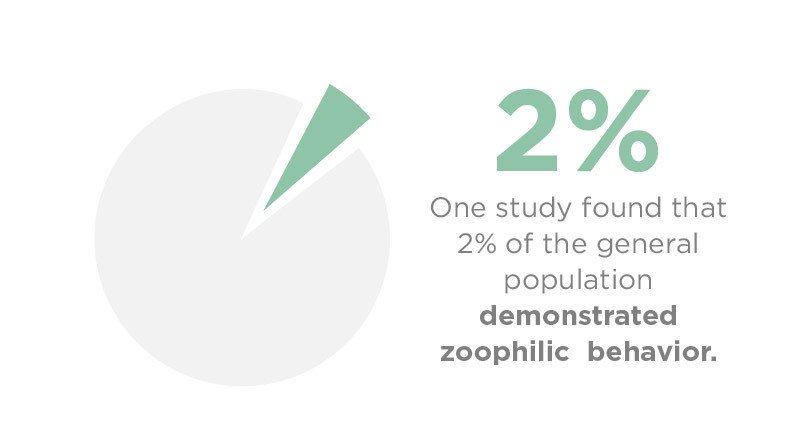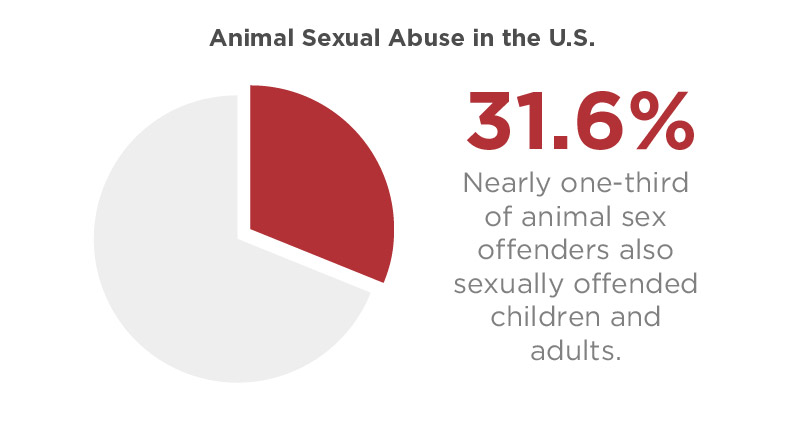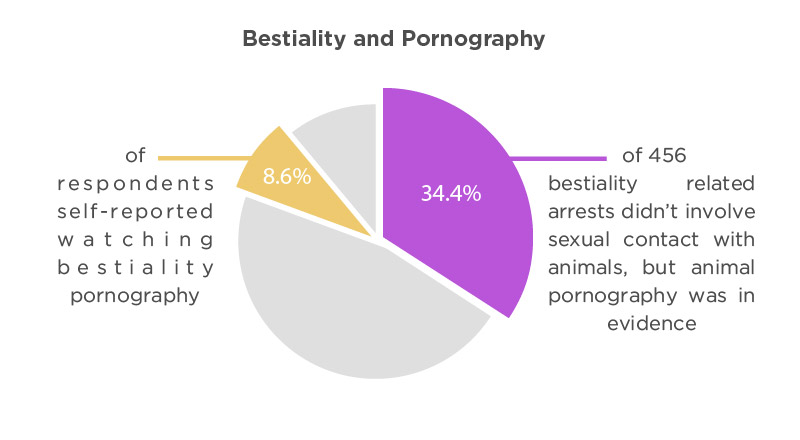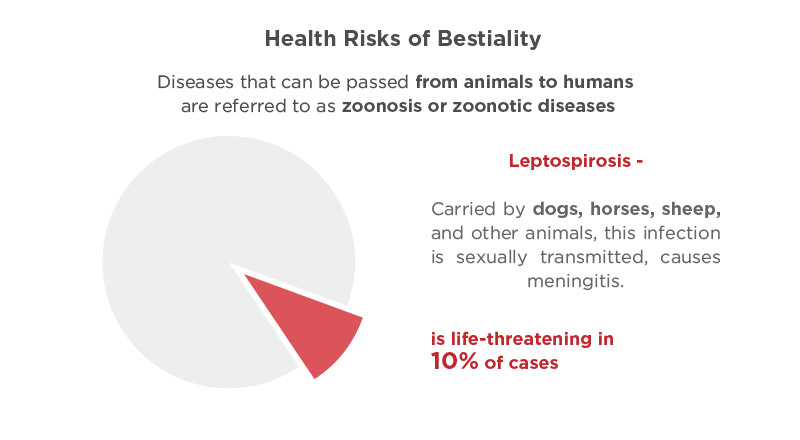Many people don’t want to talk about it, but we’ve collected data on how common bestiality is: what it is, its health risks, and where it’s common. Read on:

The cow goes “moo,” the pig goes “oink,” the horse goes “neigh,” – and the human penis goes nowhere near them.
At least it shouldn’t, but it often does. Bestiality has been around as long as humans have been getting aroused, and society has gone through phases of criminalization and acceptance.
Even though it’s illegal in most places, many state or local governments still tend to look the other way. So to curb the phenomenon of animal sexual abuse, we have to understand it.
Research on the subject is scarce (scientists don’t often want to study people who bang their pets), but we’ve scraped together data on bestiality rates, psychological factors, locations where it’s common, and more.
Here are some of the best bestial sex statistics we could find:
- One study estimates that 2% of the general population is sexually attracted to animals to some extent.
- Alabama only outlawed bestiality in 2014, and the state governor refused to sign the legislation.
- Zoophiles are commonly characterized as lonely and isolated people.
- One study found that nearly one-third (31.6%) of animal sex offenders also sexually offended children and adults.
- Four U.S. states – Hawaii, Wyoming, West Virginia, and New Mexico – still haven’t outlawed bestiality.
- In one study of bestiality-related cases in the U.S., only 31.9% of arrests resulted in prosecution.
- Hungary is one of the world’s largest bestiality porn exporters.
- Dogs are the most common victims of bestiality, followed by horses and other farm animals.
What is Bestiality?
First thing’s first, just what is bestiality?
It’s not that complicated; it’s exactly what you think it is.
Any sexual act between a human being and an animal is called bestiality.
People who commit bestiality have a variety of reasons, which are typically environmental or belief-based. Belief-based bestiality may reinforce certain myths.
Sources: Legal Information Institute, Sociology Compass
Bestiality vs. Zoophilia
Having sex with an animal and wanting to have sex with an animal aren’t necessarily the same thing. Bestiality is the act, and zoophilia is the mindset.
At least, researchers and experts agree on that some of the time. These data points paint a clearer picture:
Sexual interest in animals is usually described with three key terms: zoophilia, bestiality, and zoosexuality, which are often used interchangeably.
Some experts distinguish zoophilia as a persistent sexual interest in animals and bestiality as sexual acts with animals; oftentimes, bestiality is not driven by a sexual preference for animals.
Bestiality is cross-species sexual activity between humans and non-human animals.
Some researchers and zoophiles describe zoophilia as the desire to have sexual relationships with animals and bestiality as the sex acts alone.
Zoophilia can refer to sexual activity between humans and animals, the desire to have such relations, or to the specific paraphilia that indicates a definite sexual preference for animals over humans.
The term zoosexuality was coined by sexologist and sex therapist Hani Miletski in 2002 as a value-neutral term.
Zoosexuality is sometimes used by self-identified zoophiles in support groups and online forums to describe a sexual orientation of being sexually attracted to animals.
Sources: Journal of the American Academy of Psychiatry and the Law, Wikipedia, Sexual Deviance: Theory, Assessment, and Treatment
How Common Is Bestiality?
“Have you ever had sex with an animal?” is a survey question that isn’t likely to get a lot of honest answers. Many people are caught committing bestiality, but that implies there are a lot more people who don’t get caught.
With this in mind, it’s easy to see why the estimates fluctuate. They also vary by nation and culture throughout the world. There’s also a difference between non-practicing zoophiles (such as some “furries”) and those who sexually abuse animals, even though they are sometimes lumped together in the same category.
Here’s a look at the best available data on how common bestiality is:
One study found that 2% of the general population demonstrated zoophilic behavior.
There is a notable sub-culture of zoophiles who sometimes refer to themselves as “zoos.”
Zoophile internet forums are becoming more prevalent, and one of the largest is BeastForum, which claims to have over 1.2 million registered members and even more unregistered participants.
In a study of 171 men who committed bestiality.
A 1991 study found that psychiatric patients self-reported a 55% rate of bestiality (both sexual contact and fantasy). In contrast, medical in-patients had a 10% rate, and psychiatric staff had a 15% rate.
A 1982 study found that 7.5% of university students had interacted with an animal sexually.
Sources: Revista Colombiana de Psiquiatría, WBSM, Pediatric Education, The Journal of Sexual Medicine, International Journal of Psychosomatics, Adolescence
Animal Sexual Abuse in the U.S.

While surveys and studies can give us some insight into the people willing to self-report zoophilic behavior, the data on animal abuse arrests can tell an entirely different story.
The profiles of zoophiles caught in the act of animal sexual abuse suggest that zoophilia may be an indicator of other negative psychological traits.
A study of 456 bestiality-related arrests from 1975 to 2015 identified the following trends:
In four incidents, the offender had sex with an animal carcass.
Source: Journal of the American Academy of Psychiatry and the Law,
Bestiality by Country: Countries That Fornicate with Animals

People go to France to see the Eiffel Tower. They go to Hawaii for the beaches. They go to Amsterdam for its famous red-light district and legalized substances.
They also go to Hungary to make horse porn. Here’s a look at some of the most prolific bestiality sites and trends in countries around the world:
While bestiality is illegal in many – if not most – countries, there are still several places where it’s legal, or the law simply isn’t enforced:
As of 2021, there were no laws against bestiality in New Mexico, West Virginia, Hawaii, and Wyoming.
Bestiality and Pornography

Most things that people like to do, they also like to watch, and bestiality is no exception. There is a significant crossover between users of animal porn and child porn; however, this is not always the case and may be tied more closely to general deviant sexual behavior than to zoophilia.
Here’s a look at the numbers:
Some evidence suggests that people drawn to child porn may also possess or view animal pornography.
One study of 456 bestiality-related arrests found that 34.4% of them didn’t involve sexual contact with the animal, but animal pornography was in evidence.
One case involved the sale of “crush” videos – pornography where a small animal is crushed or tortured for sexual gratification.
Another offender produced and distributed bestiality and scat films.
One study found that:
Sources: Journal of the American Academy of Psychiatry and the Law, Computers in Human Behavior
Which Animals Are Most at Risk?
Man’s best friend is also man’s most preferred victim of animal sexual abuse. While no animal is safe, dogs often get the worst of it.
These data points highlight the animals most likely to be victims of bestiality:
Dogs are the most frequent bestiality victims, followed by horses and farm animals such as cattle, goats, pigs, chickens, etc.
Reptiles, wildlife, cats, birds, etc., are also at risk.
One study found that most bestiality arrests (83.7%) involve only one animal.
Sexually abused animals were often under a year old.
Some of the most at-risk animals in the U.S. are horses, snakes, dogs, and cows.
Sources: Journal of the American Academy of Psychiatry and the Law, The Guardian
Causes and Treatments for Bestiality
Zoophilia is a subsect of paraphilic disorder, the psychiatric condition that involves persistent sexual attraction to unusual things.
While practicing zoophiles are often chastised, shunned, and prosecuted, this is not all that should be done to mitigate animal sexual abuse. Unfortunately, treatment of zoophiles is an under-researched subject, but there are options.
Bestiality has been around as long as humanity but is still a poorly understood aspect of human sexuality.
Bestiality is typically referred to as a paraphilic disorder:
- It’s one of the best-known paraphilias and involves consistent sexual attraction to non-human animals.
- Zoolophilic practices often take place in isolated, inaccessible, and/or rural areas. Human contact may be limited, while livestock or other animals are common.
- Loneliness and isolation are common characteristics of people with zoophilia.
- An emotional bond can form between an animal and its owner, and the person may feel a special connection that leads to the humanization of the animal and sexual desire.
Paraphilia treatment, specifically for bestiality, is complex and subject to debate.
Zoophilic patients often identify as a persecuted group and assert that their practices do not harm anyone.
Psychological treatments could involve analyzing fantasies to determine which elements are sexually excitable and improving self-esteem and relational skills with humans.
Sources: Journal of Forensic Sciences, Virtual Psych Centre
Health Risks of Bestiality

No matter how you may feel about animals, it should be abundantly clear that you should not, under any circumstances, engage in sexual activity with them.
Interspecies sex is nonconsensual and often causes harm to the animal. If that wasn’t bad enough, it also poses serious health risks to the humans involved.
Diseases that can be passed from animals to humans are referred to as zoonosis or zoonotic diseases. These can include bacteria, fungi, parasites, and viruses such as:
Source: Public Health Nigeria
Conclusion
Like with any sexual deviancy, zoophilia is not necessarily the fault of anyone who experiences it. Sexuality is a neutral and imperfect aspect of the human consciousness; we define it in ourselves by the ways we nurture and act upon it. However, the clearest indicator of healthy versus unhealthy sexual behavior is consent, which animals cannot give.
As little as 2% or as much as 10% of the population at least fantasizes about animals sexually, and this is not by choice. Bestiality is more likely in those with other harmful sexual deviancies, as well as sexual offenders.
Sexual relations with animals subject humans to a variety of health risks and often physically harm the animal involved.
Some nations allow bestiality, others ignore it, and others prosecute it zealously. Society’s approach to zoophilia is mixed, but it is undeniably part of our collective sexuality.
Just as any person is responsible for practicing their own sexuality healthily and harmlessly, society also has a responsibility to address zoophilia. Therefore, expanding research on zoophilia and access to treatment options is necessary.